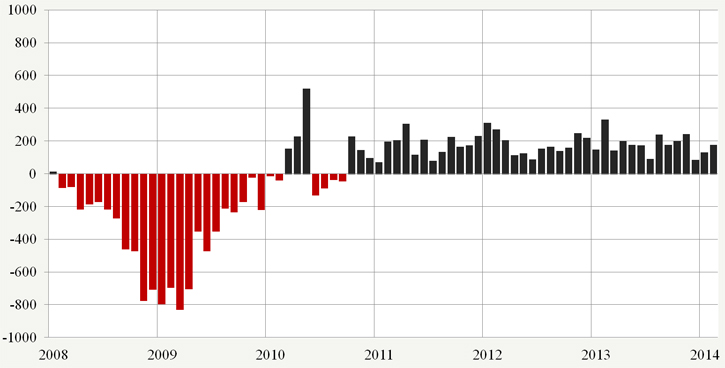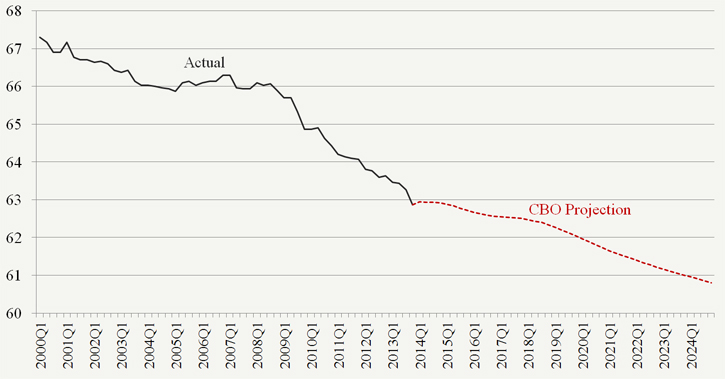March 7, 2014
February 2014 Jobs Report
Unemployment Rate: 6.7 percent
Unemployed Americans: 10.5 million
Employment
- The Department of Labor reported an unemployment rate of 6.7 percent for February 2014, up 0.1 percent from January. It reported an increase of 175,000 nonfarm jobs over last month. The employment figure for December was revised from 75,000 to 84,000 jobs created, with the figure for January revised from 113,000 to 129,000 new jobs.
- According to the Wall Street Journal, “February’s job growth of 175,000 is roughly enough to keep up with the growing population. Growth still hasn’t returned to the average pace of about 200,000 logged between June through November.”
- There is some speculation that weather could have dampened today’s employment figures. However, Federal Reserve Chair Janet Yellen discounted this in testimony earlier this week stating that the jobs report may “reflect in part adverse weather conditions, but at this point it is difficult to discern exactly how much.” The construction sector, which can be sensitive to the weather, added 15,000 jobs in February.
- The number of unemployed people rose in February to 10.5 million, an increase of 300,000 compared to last month. The average length of unemployment has also increased. In February, the average was 37.1 weeks, compared to 35.4 weeks in January and 36.9 weeks in February 2013.
- The “real” number of unemployed Americans is 20.0 million. These are people who are unemployed (10.5 million), want work but have stopped searching for a job (2.3 million), or are working part time because they can’t find full time employment (7.2 million).
- The “real” unemployment or U-6 rate is 12.6 percent for February 2014, down 0.1 percent from last month. This is the total percentage of unemployed and underemployed workers. President Obama promised a “natural unemployment” rate of 5.0 percent by now.
Job Growth Is Still Insufficient
Change from previous month in thousands

- In January, the Federal Reserve lowered its monthly bond purchases by another $10 billion, following an initial reduction of $10 billion a month announced in December 2013. Combined, the Fed is now buying $65 billion a month, down from $85 billion a month, in Treasuries and mortgage bonds. The Board of Governors is scheduled to meet March 18-19.
- Employment in February increased in construction (+15,000), professional and business services (+79,000), and food services and drinking places (+21,000). Employment in information fell by 16,000, and employment by electronics and appliance stores fell by 12,000.
Labor Force Participation
- The labor force participation rate is 63.0 percent, unchanged from last month and remaining near the lowest level in 35 years. The labor force participation rate is down 0.5 percent from a year ago.
- If the labor force participation rate were the same as when President Obama took office, the unemployment rate would be 10.5 percent.
- Based on a Congressional Budget Office’s (CBO) labor market report, the Wall Street Journal anticipates that only one-third of the millions who have dropped out of the labor force since the start of the recession in late 2007 will return in the years ahead, when the economy is stronger.
- The CBO predicts the labor force participation rate will continue to fall even after the economy recovers, down to 60.8 percent by the end of 2024.
Labor Force Participation Rate

- According to a paper from the Federal Reserve Bank of Boston, “workers that experience a job displacement of any length have substantially lower wages than non-displaced workers – an effect that persists for nearly 20 years after the unemployment episode.” This earnings gap is even more profound for the long-term unemployed.
- The share of American adults with jobs in February was 58.8 percent, unchanged from last month. This is more than four percentage points below its pre-recession peak.
- The number of long-term unemployed is 3.8 million Americans, an increase of 203,000 compared to last month. This represents 37.0 percent of the unemployed – an increase of 1.2 percent from last month. During the 1980s, when our country faced a similar recessionary period, the proportion of long-term unemployed never exceeded 27 percent.
- Today’s report could partially reflect that extended federal unemployment benefits expired for more than one million Americans at the end of December. To receive payments, people had to look for work actively, and were thus counted as part of the labor force. The loss of extended benefits could push many of the long-term unemployed either to take jobs or drop out of the workforce entirely.
- Additionally, concern has also been raised about the consistent number of Americans working part time for economic reasons – because they cannot find a full-time position or their hours have been cut back. This figure was near eight million throughout 2013.
- There were 755,000 people in February categorized as “discouraged workers.” Discouraged workers are not currently looking for work because they believe no jobs are available for them.
Weeks, Hours and Wages
- The average hourly private nonfarm payroll rose last month by nine cents to $24.31. Year-over-year hourly earnings have risen 52 cents, or 2.2 percent.
- The average work week for private nonfarm employees was 34.2 hours, down 0.1 hour in February.
Next Article Previous Article
